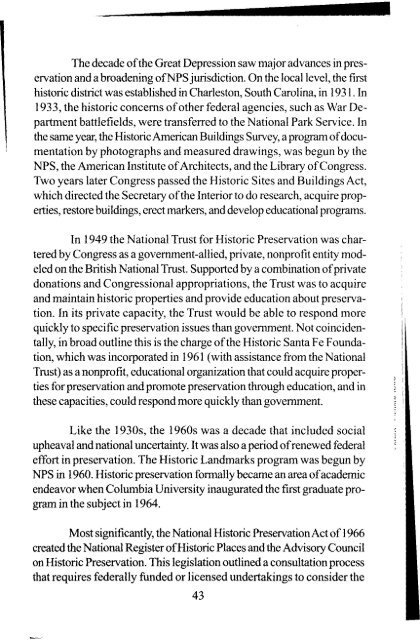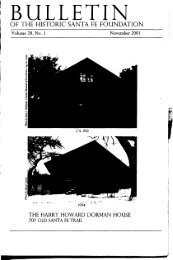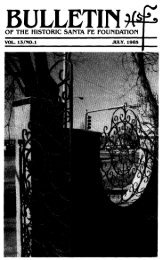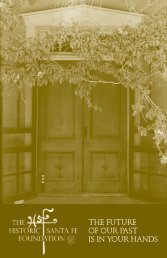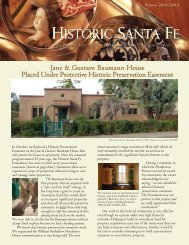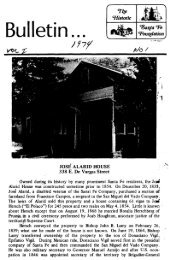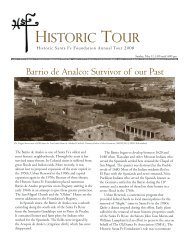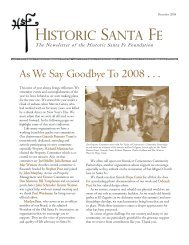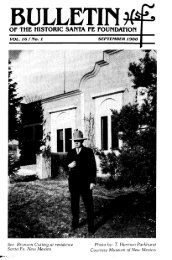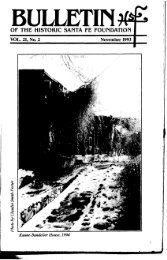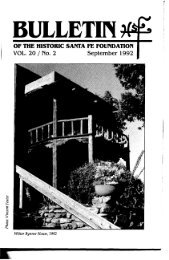Roque Tudesqui House - Historic Santa Fe Foundation
Roque Tudesqui House - Historic Santa Fe Foundation
Roque Tudesqui House - Historic Santa Fe Foundation
You also want an ePaper? Increase the reach of your titles
YUMPU automatically turns print PDFs into web optimized ePapers that Google loves.
~-------_.-<br />
The decade of the Great Depression saw major advances in preservation<br />
and a broadening ofNPS jurisdiction. On the local level, the first<br />
historic district was established in Charleston, South Carolina, in 1931. In<br />
1933, the historic concerns of other federal agencies, such as War Department<br />
battlefields, were transferred to the National Park Service. In<br />
the same year, the <strong>Historic</strong> American Buildings Survey, a program of documentation<br />
by photographs and measured drawings, was begun by the<br />
NPS, the American Institute of Architects, and the Library of Congress.<br />
Two years later Congress passed the <strong>Historic</strong> Sites and Buildings Act,<br />
which directed the. Secretary ofthe Interior to do research, acquire properties,<br />
restore buildings, erect markers, and develop educational programs.<br />
In 1949 the National Trust for <strong>Historic</strong> Preservation was chartered<br />
by Congress as a government-allied, private, nonprofit entity modeled<br />
on the British National Trust. Supported by a combination of private<br />
donations and Congressional appropriations, the Trust was to acquire<br />
and maintain historic properties and provide education about preservation.<br />
In its private capacity, the Trust would be able to respond more<br />
quickly to specific preservation issues than government. Not coincidentally,<br />
in broad outline this is the charge of the <strong>Historic</strong> <strong>Santa</strong> <strong>Fe</strong> <strong>Foundation</strong>,<br />
which was incorporated in 1961 (with assistance from the National<br />
Trust) as a nonprofit, educational organization that could acquire properties<br />
for preservation and promote preservation through education, and in<br />
these capacities, could respond more quickly than government.<br />
Like the 1930s, the 1960s was a decade that included social<br />
upheaval and national uncertainty.<br />
It was also a period of renewed federal<br />
effort in preservation. The <strong>Historic</strong> Landmarks program was begun by<br />
NPS in 1960. <strong>Historic</strong> preservation formally became an area of academic<br />
endeavor when Columbia University inaugurated the first graduate program<br />
in the subject in 1964.<br />
Most significantly, the National <strong>Historic</strong> Preservation Act of 1966<br />
created the National Register of <strong>Historic</strong> Places and the Advisory Council<br />
on <strong>Historic</strong> Preservation. This legislation outlined a consultation process<br />
that requires federally funded or licensed undertakings to consider the<br />
43


